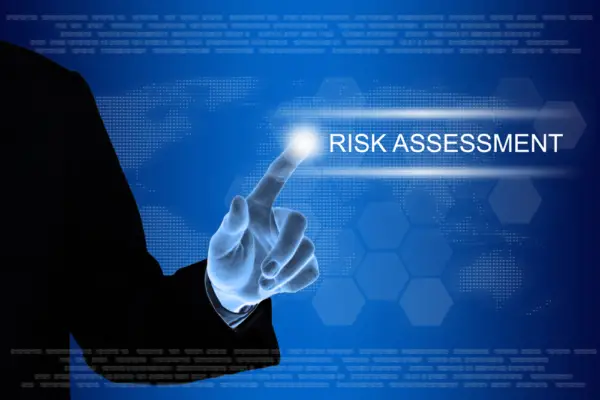CRAMM (CCTA Risk Analysis and Management Method) is a version of a well-established risk assessment methodology widely used in computing and information technology security.
It provides organizations with a systematic approach to identifying, assessing, and managing risks to their critical assets.
This article aims to provide an overview of CRAMM risk assessment tool, including its definition, types, advantages, disadvantages, and steps involved in cram risk assessment.
Firstly, the definition of CRAMM risk assessment tool will be explored, highlighting its form, purpose and key principles.
Furthermore, various types of risk assessments will be discussed to provide a comprehensive understanding of the different approaches available.
The article will then explore the advantages and disadvantages of utilizing the CRAMM methodology. This critical analysis will help readers determine its suitability for organizational requirements.
Finally, the article will outline the step-by-step CRAMM risk analysis process. Organizations can effectively implement this methodology within and improve their security frameworks and practices by understanding each stage in detail – from asset identification to mitigation planning.
In conclusion, this article and paper is an informative resource for professionals seeking knowledge about CRAMM risk assessment.
Comprehensive coverage enables readers to gain insights into this valuable tool for managing information technology security risks without any personal bias or subjective opinions influencing their decisions or understanding. The CRAMM tool is comprehensive and user-friendly, allowing assessments to be completed efficiently and tailored to specific organizational needs.

Definition of CRAMM Risk Assessment
This paper is an overview of the CRAMM (CCTA Risk Analysis and Management Method) methodology, a risk assessment method used in information security management.
CRAMM aims to identify and assess risks associated with the implementation and operation of IT systems by examining the potential threats, vulnerabilities, impacts, and countermeasures.
It follows a structured approach that involves the following:
- Identifying assets.
- Determining threats and vulnerabilities.
- Assessing impacts.
- Calculating risk levels.
- Recommending appropriate control measures.
Overview of CRAMM Methodology
An in-depth understanding of the CRAMM methodology allows for an unbiased and systematic assessment of risks, fostering a sense of security and confidence among stakeholders.
The CRAMM (CCTA Risk Analysis and Management Method) is one of the widely recognized risk assessment methodologies used to evaluate the security risk level within an organization.
It provides a comprehensive risk assessment tool that helps identify and analyze potential vulnerabilities, threats, and impacts on information systems.
Key features of the CRAMM methodology include:
- Structured approach: The CRAMM methodology follows a well-defined process that systematically covers all risk assessment aspects.
- Holistic perspective: It considers internal and external factors when assessing risks, providing a comprehensive view.
- Tailored assessments: The methodology can be customized to fit specific organizational requirements, allowing flexibility.
- Decision support: It offers guidance in making informed decisions regarding risk treatment options based on identified vulnerabilities.
The CRAMM methodology is a valuable tool for organizations seeking a robust and objective approach to evaluating their security risks.
Types of Risk Assessment
This will focus on the different types of risk assessment methods. There are three main types: qualitative risk assessment, quantitative risk assessment, and combined qualitative and quantitative risk assessment.
Qualitative risk assessment involves the subjective evaluation of risks based on their likelihood and impact without assigning specific numerical values.
On the other hand, quantitative risk assessment involves a more objective approach by quantifying risks through mathematical models and calculations.
Lastly, combined qualitative and quantitative risk assessments integrate both approaches to provide a more comprehensive understanding of risks by considering subjective judgments and numerical data
Qualitative Risk Assessment
Qualitative risk assessment involves analyzing risks based on their characteristics and potential impacts, comprehensively understanding the overall risk landscape.
This method is commonly used in CRAMM (CCTA Risk Analysis and Management Method) risk assessment, which focuses on identifying vulnerabilities and assessing the associated threats and impacts.
It allows organizations to prioritize risks based on severity and likelihood, enabling effective risk management strategies.
Various risk assessment methods can be utilized to conduct and improve a qualitative risk assessment, using practices such as brainstorming sessions, interviews with subject matter experts, or reviewing historical data.
The output of this process is often represented in a matrix format that categorizes risks based on their likelihood and impact levels. By assigning scores or ratings to each risk, decision-makers can identify high-risk areas requiring immediate attention.
Qualitative risk assessment is crucial in the CRAMM risk assessment framework by providing valuable insights for effective risk management strategies.
Quantitative Risk Assessment
Quantitative risk assessment uses numerical data and a form of statistical analysis to evaluate risks and decisions, quantitatively measuring their likelihood and potential impact.
This approach to risk assessment is particularly useful in information security, where organizations need to prioritize their resources effectively.
One commonly used method for quantitative risk assessment is the CCTA Risk Analysis and Management Method (CRAMM), which utilizes a mathematical model to assess risks based on various risk factors such as vulnerability, threat, and asset value.
Assigning values to these risk factors, and applying statistical techniques, CRAMM provides organizations with a clear understanding of their risk exposure.
This enables them to make informed decisions regarding risk mitigation strategies and resource allocation. Quantitative risk assessment offers a systematic and objective approach to identifying and managing risks in an organization’s operations.
- Quantitative risk assessment helps organizations prioritize resources efficiently.
- CCTA Risk Analysis and Management Method (CRAMM) employs a mathematical model.
- Statistical techniques provide insights into an organization’s risk exposure.
Combined Qualitative and Quantitative Risk Assessment
Combined qualitative and quantitative risk assessment allows organizations to comprehensively understand their risk landscape by integrating subjective judgments with numerical data and statistical analysis.
The CRAMM (CCTA Risk Analysis and Management Method) risk assessment framework is one approach that combines qualitative and quantitative elements to evaluate risks.
Qualitative aspects involve expert opinions and subjective assessments, while quantitative factors are based on measurable data such as financial figures or historical incident rates.
Combining these approaches, organizations can identify potential risks more effectively, prioritize them based on their impact and likelihood, and develop appropriate risk mitigation strategies.
This integrated approach enables decision-makers to make informed choices regarding resource allocation and risk management activities.
Additionally, it helps organizations develop a holistic view of the risks, facilitating better planning for both short-term and long-term strategies.
Advantages and Disadvantages of the CRAMM Methodology
The CRAMM (CCTA Risk Analysis and Management Method) methodology has several advantages, making it a popular choice for risk assessment. Firstly, it provides a structured and systematic approach to identifying, analyzing, and evaluating risks within an organization’s information systems.
Secondly, it allows for identifying vulnerabilities and threats specific to the organization’s environment, enabling targeted risk mitigation strategies.
However, there are also some disadvantages associated with the CRAMM methodology. One major limitation is its complexity, which requires trained professionals to implement and interpret and analyze the results effectively.
Additionally, the extensive documentation process can be time-consuming and resource-intensive for organizations with limited computing resources.

What Is Information Risk Management
Advantages of the CRAMM Methodology
One of the benefits of using the CRAMM methodology is its comprehensive approach to risk assessment, which allows organizations to gain a holistic understanding of their vulnerabilities and develop effective mitigation strategies. This methodology offers several important advantages:
- Thorough analysis: CRAMM provides a structured framework for identifying and assessing risks across various areas, including information technology systems, physical security, personnel, and processes.
- Customization allows organizations to tailor the risk assessment process to their needs and requirements.
- Prioritization: CRAMM helps prioritize risks based on their potential impact and likelihood, enabling organizations to focus resources on addressing high-risk areas first.
- Compliance with standards: The methodology aligns with recognized international standards such as ISO/IEC 27001, ensuring that organizations adhere to best practices in risk management.
- Continuous improvement: CRAMM emphasizes ongoing monitoring and review of risks, facilitating continuous improvement in an organization’s security posture.
Utilizing the advantages of the CRAMM methodology, organizations can enhance their risk management capabilities and better protect themselves against potential threats.
Disadvantages of the CRAMM Methodology
While the CRAMM methodology system has been praised for its numerous advantages in risk assessment, it is important to recognize that it also comes with certain disadvantages.
One of the key drawbacks of the CRAMM risk assessment method is its complexity and time-consuming nature. The process involves significant data collection and analysis, which can be burdensome for organizations with limited resources or expertise.
Additionally, the CRAMM methodology may not always provide accurate or reliable results due to its reliance on subjective judgments and assumptions made by assessors. This subjectivity can introduce bias and potentially lead to incorrect risk assessments.
Finally, using the CRAMM methodology requires continuous training and updates to stay current with evolving threats and vulnerabilities. This makes this version of it less practical for organizations seeking a quick, easy risk assessment solution.
Steps Involved in a CRAMM Risk Analysis
The important first step in a CRAMM risk analysis system involves identifying assets and assessing their value. This is crucial as it helps organizations understand the importance of their assets and prioritize them accordingly.
Organizations can better allocate resources and protect the most critical ones by assigning value to each asset.
The second step is identifying threats to these assets, allowing organizations to address potential risks and vulnerabilities proactively.
Organizations can develop effective strategies to mitigate potential threats and enhance overall security by systematically analyzing them.
Step 1: Identifying Assets and Assessing their Value
To effectively conduct a CRAMM risk assessment, it is crucial to begin by identifying the assets involved and assessing their value. Risk assessment plays a significant role in ensuring business continuity.
Identifying assets involves recognizing all organizational elements contributing to its operations, including physical infrastructure, software systems, data repositories, and human resources.
Each asset holds a certain level of importance and value to the organization’s overall functioning and success.
Assessing their value entails determining the impact of potential risks on these assets regarding financial losses, reputational damage, operational disruptions, or legal consequences.
This step allows organizations to prioritize their resources and efforts toward protecting the most critical assets from potential threats.
Comprehensively identifying assets and assessing their value, organizations can better allocate resources for risk mitigation strategies and enhance their resilience against potential vulnerabilities.
Step 2: Identifying Threats to Assets
Identifying threats to assets involves uncovering potential dangers that can jeopardize the integrity, availability, and confidentiality of an organization’s critical elements, leading to significant disruptions, financial losses, or reputational harm.
This step is crucial in understanding the vulnerabilities that could impact an organization’s assets.
To effectively identify threats, organizations should consider the following:
- External Threats include risks from outside sources such as natural disasters, cyber-attacks, or economic changes.
- Internal Threats refer to organizational risks, such as employee negligence or intentional misconduct.
- Technological Threats involve risks associated with technological advancements and their potential vulnerabilities.
- Regulatory Compliance Threats: These pertain to risks related to non-compliance with legal requirements and regulations.
Systematically identifying these threats during the risk assessment, organizations can better understand their exposure and develop appropriate mitigation strategies to safeguard their valuable assets.
Can CRAMM Risk Assessment be used in any industry or is it specific to certain sectors?
The applicability of risk assessments varies across industries. While some risk assessment methodologies are tailored for specific industry sectors, it is unclear whether the CRAMM risk assessment can be universally applied across industry or has sector-specific limitations.
How does CRAMM differ from other risk assessment methodologies?
Cramm risk assessment differs from other methodologies cram risk assessment by incorporating a comprehensive approach to technical and organizational risk management aspects.
It emphasizes identifying, analyzing, and prioritizing risks to develop effective mitigation strategies.
Are there any legal or regulatory requirements associated with implementing CRAMM Risk Assessment?
Legal and regulatory requirements associated with risk assessment vary depending on the industry and jurisdiction.
Organizations must comply with relevant laws, regulations, and standards when implementing any risk assessment methodology, including CRAMM.
What are some common challenges or obstacles organizations face when implementing CRAMM Risk Assessment?
Organizations common challenges when implementing risk assessment include lack of knowledge or understanding, resistance to change, resource constraints, difficulty prioritizing risks, and maintaining ongoing risk management processes.
Are any specific training or certifications available for individuals or teams using CRAMM Risk Assessment?
Specific training and certification programs are available for individuals or teams interested in using CRAMM risk assessment. These programs provide the necessary knowledge and skills to implement CRAMM within organizations effectively.

The CRAMM risk assessment methodology is valuable for organizations to identify and mitigate potential risks. It systematically analyzes and evaluates risks, allowing for informed decision-making and effective risk management strategies.
However, like any method, it has advantages and disadvantages that must be considered. Overall, the CRAMM risk assessment offers a structured framework to help organizations enhance their security measures and protect their assets from threats.

Chris Ekai is a Risk Management expert with over 10 years of experience in the field. He has a Master’s(MSc) degree in Risk Management from University of Portsmouth and is a CPA and Finance professional. He currently works as a Content Manager at Risk Publishing, writing about Enterprise Risk Management, Business Continuity Management and Project Management.

